
Browse an alphabetical list of photographs. These historical images portray people, places, and events before, during, and after World War II and the Holocaust.
<< Previous | Displaying results 1651-1675 of 2641 for "Photo" | Next >>
Norbert Yasharoff, a Bulgarian Jew, wearing the compulsory star of David. His young sister was not then required to wear a star. Pleven, Bulgaria, between May and September 1943.
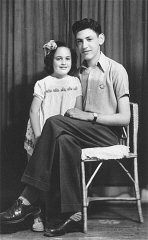
Norman and Amalie Salsitz with their first grandchild, Dustin. March 11, 1983. With the end of World War II and collapse of the Nazi regime, survivors of the Holocaust faced the daunting task of rebuilding their lives. With little in the way of financial resources and few, if any, surviving family members, most eventually emigrated from Europe to start their lives again. Between 1945 and 1952, more than 80,000 Holocaust survivors immigrated to the United States. Norman was one of them.
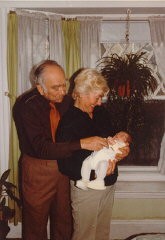
Norman Salsitz and Amalie Petranka shortly after they met (under their assumed identities of, respectively, Felicja Milaszewska and Tadeusz Zaleski). Krakow, Poland, March 15, 1945. With the end of World War II and collapse of the Nazi regime, survivors of the Holocaust faced the daunting task of rebuilding their lives. With little in the way of financial resources and few, if any, surviving family members, most eventually emigrated from Europe to start their lives again. Between 1945 and 1952, more than…
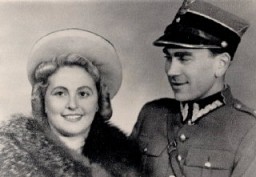
Norman Salsitz holds a photograph of himself and Amalie from 1945. 2004. With the end of World War II and collapse of the Nazi regime, survivors of the Holocaust faced the daunting task of rebuilding their lives. With little in the way of financial resources and few, if any, surviving family members, most eventually emigrated from Europe to start their lives again. Between 1945 and 1952, more than 80,000 Holocaust survivors immigrated to the United States. Norman was one of them.
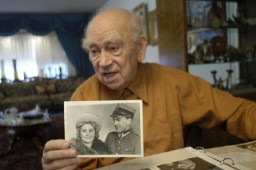
Norman Salsitz holds a photograph of his wife, Amalie, and daughter, Esther. 2004. With the end of World War II and collapse of the Nazi regime, survivors of the Holocaust faced the daunting task of rebuilding their lives. With little in the way of financial resources and few, if any, surviving family members, most eventually emigrated from Europe to start their lives again. Between 1945 and 1952, more than 80,000 Holocaust survivors immigrated to the United States. Norman was one of them.
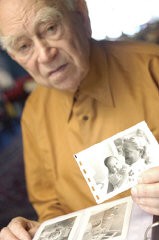
Norman (with camera) in the United States. August 1948. With the end of World War II and collapse of the Nazi regime, survivors of the Holocaust faced the daunting task of rebuilding their lives. With little in the way of financial resources and few, if any, surviving family members, most eventually emigrated from Europe to start their lives again. Between 1945 and 1952, more than 80,000 Holocaust survivors immigrated to the United States. Norman was one of them.
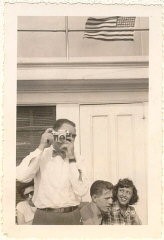
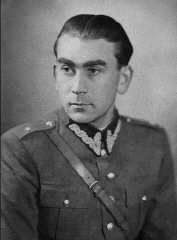
Norman Salsitz looks through his prewar family photographs. 2004. With the end of World War II and collapse of the Nazi regime, survivors of the Holocaust faced the daunting task of rebuilding their lives. With little in the way of financial resources and few, if any, surviving family members, most eventually emigrated from Europe to start their lives again. Between 1945 and 1952, more than 80,000 Holocaust survivors immigrated to the United States. Norman was one of them.
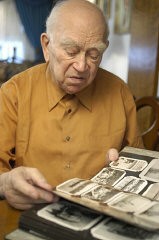
Norman Salsitz while under the assumed identity Tadeusz Zaleski. Legnica, Poland, 1945.
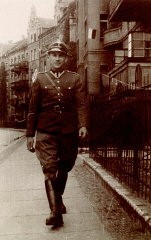
This 1929 portrait shows Norman Salsitz with his niece, Szandla Weinstein. Picture taken in front of a photographer's backdrop in the Kolbuszowa marketplace.
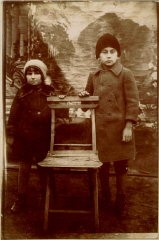
This 1925 photograph taken in Kolbuszowa, Poland, shows Norman Salsitz (at right) with his sister Rachel (left) and brother David (center). With the end of World War II and collapse of the Nazi regime, survivors of the Holocaust faced the daunting task of rebuilding their lives. With little in the way of financial resources and few, if any, surviving family members, most eventually emigrated from Europe to start their lives again. Between 1945 and 1952, more than 80,000 Holocaust survivors immigrated to…
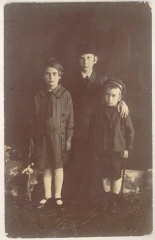
Norman's daughter, Esther, at age one. April 1957. With the end of World War II and collapse of the Nazi regime, survivors of the Holocaust faced the daunting task of rebuilding their lives. With little in the way of financial resources and few, if any, surviving family members, most eventually emigrated from Europe to start their lives again. Between 1945 and 1952, more than 80,000 Holocaust survivors immigrated to the United States. Norman was one of them.

Norman's grandchildren, Dustin, Aaron, and Michael. September 30, 1993. With the end of World War II and collapse of the Nazi regime, survivors of the Holocaust faced the daunting task of rebuilding their lives. With little in the way of financial resources and few, if any, surviving family members, most eventually emigrated from Europe to start their lives again. Between 1945 and 1952, more than 80,000 Holocaust survivors immigrated to the United States. Norman was one of them.
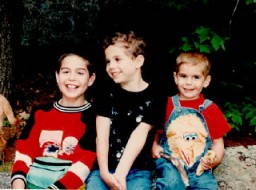
Norman's grandchildren, Michael, Dustin, and Aaron in 1997. With the end of World War II and collapse of the Nazi regime, survivors of the Holocaust faced the daunting task of rebuilding their lives. With little in the way of financial resources and few, if any, surviving family members, most eventually emigrated from Europe to start their lives again. Between 1945 and 1952, more than 80,000 Holocaust survivors immigrated to the United States. Norman was one of them.
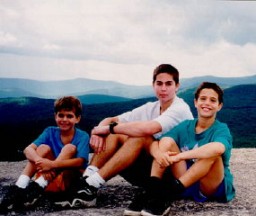
Prewar portrait of Norman's parents, Isak and Ester, taken in Kolbuszowa, Poland, in 1934 when Isak's brother visited from America. Isak's six siblings all emigrated to America. Isak and Esther, who remained in Kolbuszowa, both perished during the Holocaust: Isak was killed in the Kolbuszowa ghetto on April 28, 1942, and Esther was killed in the Belzec killing center in July 1942. With the end of World War II and collapse of the Nazi regime, survivors of the Holocaust faced the daunting task of…
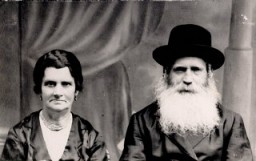
Norman's sisters Malcia, Matla, and Rachel eat bagels in the doorway of their mother's store. The red and white stripes on the door frames indicate that the store carried cigarettes, matches, and sugar, consumer goods regulated by a state monopoly. Kolbuszowa, Poland, 1934. With the end of World War II and collapse of the Nazi regime, survivors of the Holocaust faced the daunting task of rebuilding their lives. With little in the way of financial resources and few, if any, surviving family members, most…
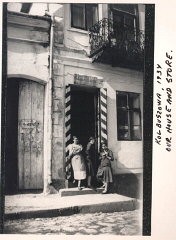
Norman's daughter, Esther, at three weeks of age, with her mother, Amalie. September 1956. With the end of World War II and collapse of the Nazi regime, survivors of the Holocaust faced the daunting task of rebuilding their lives. With little in the way of financial resources and few, if any, surviving family members, most eventually emigrated from Europe to start their lives again. Between 1945 and 1952, more than 80,000 Holocaust survivors immigrated to the United States. Norman was one of them.
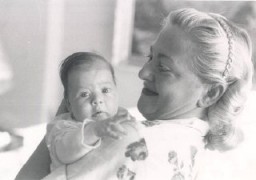
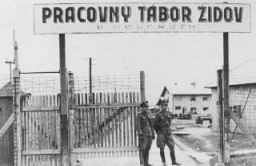
View of a bridge spanning a canal in Nuremberg. The houses and bridge are decorated with Nazi flags and banners. Photograph taken by Julien Bryan in Nuremberg, Germany, 1937.
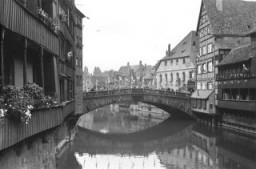
A group of nursery school children at the Heart Mountain Relocation Center in Wyoming, January 4, 1943. The Heart Mountain Relocation Center was one of ten relocation centers where Japanese Americans were forcibly deported.
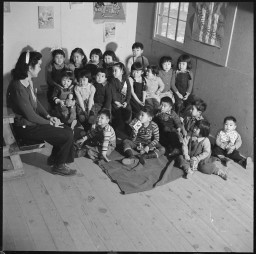
Some of the nursing staff of the "euthanasia" clinic at Hadamar stand outside of the institution after the arrival of US forces, April 5, 1945. Irmgard Huber, the head nurse of the clinic, is probably the person standing fifth from the right. © IWM EA 62183
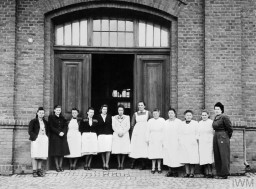
In Berlin, thousands of Party officials, Hitler Youth members, and Labor Service leaders take an oath of loyalty read by Rudolf Hess in Munich and broadcast across Germany. Berlin, Germany, February 25, 1934.
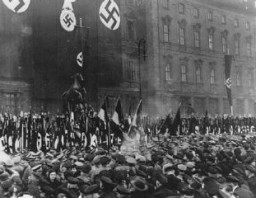
Adolf Hitler addresses German officers after the occupation of Danzig. Even before the surrender of Poland, Hitler affirmed the incorporation of the Danzig District into the Greater German Reich. Danzig, September 19, 1939.

Excerpt from Anne Frank's diary for the date October 10, 1942: "This is a photograph of me as I wish I looked all the time. Then I might still have a chance of getting to Hollywood. But now I am afraid I usually look quite different." Amsterdam, the Netherlands.
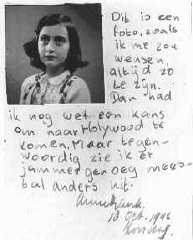
Two SS officers and a guard dog in the Janowska concentration camp. Janowska, Poland, January 1942–November 1943.
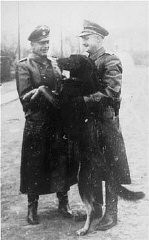
We would like to thank Crown Family Philanthropies, Abe and Ida Cooper Foundation, the Claims Conference, EVZ, and BMF for supporting the ongoing work to create content and resources for the Holocaust Encyclopedia. View the list of donor acknowledgement.